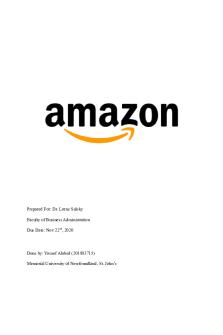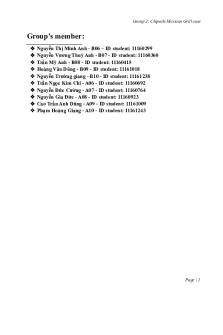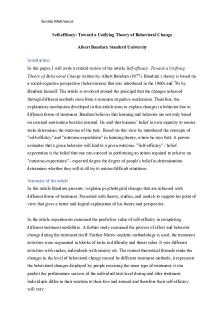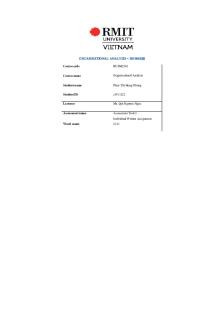Busm1100 organisations assignment 2 individual PDF

| Title | Busm1100 organisations assignment 2 individual |
|---|---|
| Course | Organisational Analysis |
| Institution | Royal Melbourne Institute of Technology |
| Pages | 10 |
| File Size | 179.2 KB |
| File Type | |
| Total Downloads | 555 |
| Total Views | 627 |
Summary
ORGANISATIONSBUSMAssignment 2 Consultancy ReportSubmitted by: -Lecturer: Foo Lee HuanWord count: 1876Lessons learned from the process improvement pilot: a critical functionalist perspective Emile Durkheim’s functionalist theory views organisations as a machine-like system, with every staff being all...
Description
ORGANISATIONS BUSM1100
Assignment 2 Consultancy Report
Submitted by: -
Lecturer: Foo Lee Huan
Word count: 1876
Lessons learned from the process improvement pilot: a critical functionalist perspective Emile Durkheim’s functionalist theory views organisations as a machine-like system, with every staff being allocated a vital and specific function so as to ensure the “machine” operates smoothly. Adopting this functionalist view is desirable because it is acknowledged as an innovation process that aids in achieving the targets for fast and reliable emergency care and minimises
treatment
mistakes
(Hirschheim
&
Klein
1989).
Our predecessor consultant proposed the provision of allowing nurses more freedom in managing the patients. Nurses were granted permission to order preliminary tests for low-risk patients as well as adopt an advisory role to advise doctors on the sequence patients should be attended. This segregation of employees by their functions is intended to create a network of interdependent roles such that every sequence of action is connected through a clear chain of command for instructions to be more swiftly distributed down the chain, overall promoting seamless integration (Morgan 1997). Parson’s theory of social action presumes that when people have awareness of their own functions, they can then effectively work together despite having different roles (Burrell & Morgan 1997). All in all, this integration champions streamlining and labour-saving by removing the “waste” in the system in the form of doctors' time (Wu & Ji 2016). The consultant also adopted the “Kanban” system to visual record the order and duration of our patients' journey to assure that the government-established targets are met. This visual management system is beneficial in identifying areas for improvement through statistical control in measuring their performance.
The main idea of functionalism holds that there can only be one reality, hence it focuses on improving means while assuming that the outcomes are unambiguously agreed upon by all. It then constructs standardised structures, focused on implementation and subsequent enhancements to the structures by rational thinking, free of human choices, which is regarded as the 'interferences to maximum efficiency or effectiveness' (Burrell & Morgan 1979). Inevitably, the true reality is that outcomes are always controversial and a point of contention, particularly in the medical field. ED staff saw our predecessor’s utilisation of these management systems as a “naïve view of reality” as it had neglected the nuances of choices made and the complicated routes patients are referred through (Burrell & Morgan 1997).
Functionalists conveniently overlook that individuals in an organisation can have autonomy and the ability to oppose new management systems through unwillingness to change (Hirschheim & Klein 1989). This unwillingness is seen as a fault in the system, and functionalists continue to deal with the means. Failure to focus on rationalising the outcomes gives rise to misunderstanding why resistance to change is present. This leads to a vicious loop of development of the system based on the established assumption of functionalism - the 'need' for conformity to the requirements of the system, of its organisational goals and mechanisms (Mehri 2006). This results in incremental development but no true innovative breakthroughs (Mehri 2006). As noted from Klabbers’ research (2015), the failure to address conflict and power issues in the hospital results in doctors behaving in a self-governing manner due to their preconceived belief that their professional judgement is above that of nurses and thus nurses tend to be equally uncomfortable with playing an advisory role. As such, our predecessor was unsuccessful in their adoption of the functionalist approach as they had neglected the knowledge that informal and social factors strongly influence an organisation (Burrell & Morgan 1979), hence misinterpreting facts in favour of the naive assumption that human conduct or resistance can be explained in terms of cause and effect.
The value of incorporating interpretivism / social relativism into the design of a new process improvement project Interpretivism/social relativism was theorised to have a deeper understanding of the knowledge of our current society, the approach also explores our society subjectively on a level that accounts for every individuals’ experience (Burrell & Morgan 1979).
The stakeholder theory states that for organisations to succeed, they should strive to do right by all their stakeholders (McAbee 2021). From the hospital’s internal stakeholders of employees’ level, it is evident that before our predecessor implemented their system, the staff were not informed of the new changes to come. Multiple rounds of surveys and interviews are necessary in order to successfully engage the interpretivism approach (Organizational Communication Channel 2017). The improvement advisor and both internal and external stakeholders had minimal communication with the staff regarding the changes moving forward. This lack of
communication left out the important understanding and account of the doctors' and nurses' views and therefore eventual resistance to the new system. The predecessors utilised the functionalist approach of viewing the organisation as a single machine, creating a pilot whereby the new system aids the ED issue in theory but not factually. Thus the failure of the pilot is largely attributed to the minimal communication and involvement from relevant stakeholders throughout the development process.
A solution should always stem from within the participant's point of view, rather than the observer's (Burrell & Morgan 1979). The process should have begun with consultation with the ED doctors and nurses, as well as some patients. Recommendations can also be gathered as they build the foundation for new ideas and development (Collins, Muthusamy & Carr 2015). It is crucial to see things through the frame of each organisational staff (Gioia & Pitre 1990) as they are the ones with first-hand experience of the problem and the key to insights and rationale behind the issue. Having the staff directly involved in the trial period would have enabled any potential issues to be raised and immediately addressed by the consultant and improvement advisor. Furthermore, direct involvement is proven to support the staff in understanding the changes to be made and how it affects their work (Gast, Probst & Simpson 2020), consequently encouraging them to be less resistant and ultimately building a stronger organisational culture and shared mission (Hirschheim & Klein 1989).
Lastly, the legitimation of the new system was undermined by the staff as they could not understand how the Toyota Production System can be applied in the ED setting, whereby every patient faces differing problems with highly unique nuances. This was a vital error, without the involvement and shared agreement between the staff, the proper understanding of the system remains unachievable (Burell & Morgan 1979). It was also brought up that the physical implementation of the “Kanban” board was not an accurate reflection of the intricate journey patients experience.
Consultation Recommendations Our consultancy team is proposing the ED’s adoption of the interpretivists Total Quality Management Approach (TQM). TQM involves 3 key stages, namely 5s, Kaizen and Total
Quality Management. It can aid the prevention of medical and admin challenges, refine the hospital’s processes and raise patient satisfaction.
Firstly, 5s is an organisational methodology that stands for Japanese words which translate to "sort", "set in order", "shine", "standardize", and "sustain". It is designed to minimise “waste” while optimising efficiency through the maintenance of an orderly workplace and using visual cues to attain more consistent operational results (Lean Production n.d.). Secondly, the Kaizen approach is a problem-solving, continuous improvement based approach where small changes can reap huge changes (Daniel n.d.). The Kaizen cycle follows a plan-do-check-act framework. Our team proposes the recruitment of more medical interns which may aid in easing the demand of professional help required with increasing patient load. Finally, TQM, that is linking back to the 5s while monitoring that all is properly managed and checking back on productivity, quality, delivery, costs as well as safety.
Proposed consultation process: challenges and limitations As with all new approaches, there are bound to be challenges and limitations. The biggest challenge would be the ongoing COVID-19 pandemic. Our new approach calls for an increase in hospital staff due to the recruitment of new interns which is currently unfavourable as pandemic restrictions pushes for as little contact with people as possible. The hospital would also have to account for additional expenses required for the recruited interns. As for limitations, the interpretivism approach does not provide an evaluation and consideration of our society’s current situation, neglecting our looming situation of the global pandemic. The approach puts heavy emphasis on the participation process and forsakes the consequences. In this case, it can be seen in the stressing of including the hospital’s staff in the development process as well as having more recruitment but sparing no mind on the need for expenses and the dangers of COVID-19. Moreover, this bottom-up approach demolishes the superior mindset of the top management as every employee’s perspective and thoughts would be valid and accounted for. In the process of this data collection, there would also be the challenge of obtaining accurate data from those who choose to lack transparency in the process (Hirschheim & Klein 1989). As there is no standard set as a guide, the data collected, specifically in the form of feedback may then be disorganised
and complicated to consolidate as every individual has a different end in mind and it is not possible to satisfy all (Burrell & Morgan 1979).
Reflections on consultancy assumptions and their strengths and limitations An organisation consists of individual parts that need to work interdependently and collectively to form a cohesive organisation (Howard et al. 2017). As consultants, our job is to provide our views on required problems in order to run and manage the organisation in an enhanced manner, thus fundamentally, we must be subject matter experts (Burrell & Morgan 1979). We are responsible for developing and introducing enhanced hospital process management solutions and maintaining a better workflow. Having said that, being knowledgeable plays a critical part in creating productivity for the organisation (Faraji-Khiavi, Ghobadian & Moradi-Joo 2015). Withal, functionalism supports productivity and efficiency.
It is important to recognise knowledge creation and learning before we can understand how a consultant embodies assumptions about organisations and society. One’s knowledge is built upon personal experiences and confirmations. To fully comprehend knowledge, it is necessary to recognise the social construct of society, which specifies the social process formed via activity and interaction that continuously produces a shared reality. Gaining and sharing knowledge is a key part of a consultant’s work. Hence, developing an applicable system requires a consultant to obtain differing views of order and regulations (Berry & Oakley 1993). This is the critical mistake that our predecessor had overlooked.
In the eyes of an interpretivist, an organisation is a motivated by participation and shared understandings of employees. Though this paradigm is based upon subjectivity, it is an approach that is highly accepted by organisations as it provides employees with a better sense of purpose in the workplace. A functionalist, on the flipside, views organisations as a homogenous system, aiming for precision to achieve their mission. They are objective in nature and straightforward in supporting effectiveness and efficiency. Through both paradigms, a consultant can bring out an organisation’s efficiency without forgoing the significance of their employees’ perspectives
which drives the organisation (Burrell & Morgan 1979). As our predecessor had implemented a new system through a functionalist lens, it was expected to be resisted by the employees.
Embracing both paradigms would give an upper hand to organisations that is striving for better functionality. Interpretivism helps organisations to accept flexibility through embracing the different stakeholders' views while Functionalism helps organisations to reach maximum efficiency by exploring calculable sequences through systematic testing and operations (Newstrom & Davis 1989). However, it can still be concluded that including all the four paradigms in the ”order/regulation - conflict/radical change" axis is the most ideal and advisable for contemporary organisations of today (Almas & Krumsvik 2008).
References Almas, A G & Krumsvik, R 2008, ‘Teaching in technology-rich classrooms: Is there a gap between teachers’ intentions and ICT practices?’, Research in Comparative and International Education, vol. 3, no. 2, pp. 103-121. Berry, A & Oakley, K 1993, ‘Consultancies: agents of organisational development. Part 1’, Leadership & Organization Development Journal, vol. 14, no. 5, pp. 12-19. Burrell, G & Morgan, G 1979, Sociological Paradigms and Organisational Analysis: Elements of the Sociology of Corporate Life, Routledge, Taylor & Francis eBooks database.
Collins, K F, Muthusamy, S K & Carr, A 2015, ‘Toyota production system for healthcare organisations: prospects and implementation challenges’, Total Quality Management, vol. 26, no. 8, pp. 905-918. Daniel, D n.d., Kaizen (continuous improvement), TechTarget, viewed on 23 March 2022,
Faraji-Khiavi, F, Ghobadian, S & Moradi-Joo, E 2015, The association between effectiveness of the management processes and quality of health services from the perspective of the managers in the university hospitals of Ahvaz, Iran, Journal of Medicine and Life, vol. 8, no. 4, pp. 219–224. Gast, A, Probst, N & Simpson, B 2020, ‘Purpose, not platitudes: A personal challenge for top executives, The McKinsey Quarterly. Gioia, D & Pitre, E 1990, Multiparadigm Perspectives on Theory Building, The Academy of Management Review, vol. 15, no. 4, pp. 584.
Hirschheim, R & Klein, H K 1989, Four Paradigms of Information Systems Development, Communications of the ACM, vol. 32, no. 10, pp. 1199-1216.
Klabbers J 2015, The EJIL Foreword: The Transformation of International Organizations Law, European Journal of International Law, vol. 26, no. 1, pp. 9-82.
Lean Production n.d., WHAT IS THE 5S METHODOLOGY?, Lean Production, viewed on 23 March 2022,
McAbee, J 2021, What is stakeholder theory?, Wrike, viewed on 23 March 2022,
Mehri, D 2006, The Darker Side of Lean: An Insider’s Perspective on the Realities of the Toyota Production System. Academy of Management Perspectives, vol. 20, no. 2, pp. 21–42.
Morgan, G 1997, ‘Morgan’s Images of Organization’, SAGE Publications, pp. 18-22.
Organizational Communication Channel 2017, Research Paradigms by Burrell and Morgan, YouTube, 21 September, Organizational Communication Channel, New York, viewed 23 March 2022,
Wu, C & Ji, Y 2016, Resource Allocation in Multiple Product Design Projects: A Bi-level Programming Approach, International Journal of Control and Automation, vol. 9, no. 1, pp. 271280....
Similar Free PDFs

Report - Assignment 2 : Individual
- 11 Pages

Individual Assignment 2 MGT420
- 6 Pages

Assignment 2 - Individual Case Study
- 11 Pages

Individual Assignment
- 26 Pages

Individual Assignment
- 20 Pages

Individual assignment
- 5 Pages

Individual assignment
- 3 Pages

MGT 162 INDIVIDUAL ASSIGNMENT
- 24 Pages
Popular Institutions
- Tinajero National High School - Annex
- Politeknik Caltex Riau
- Yokohama City University
- SGT University
- University of Al-Qadisiyah
- Divine Word College of Vigan
- Techniek College Rotterdam
- Universidade de Santiago
- Universiti Teknologi MARA Cawangan Johor Kampus Pasir Gudang
- Poltekkes Kemenkes Yogyakarta
- Baguio City National High School
- Colegio san marcos
- preparatoria uno
- Centro de Bachillerato Tecnológico Industrial y de Servicios No. 107
- Dalian Maritime University
- Quang Trung Secondary School
- Colegio Tecnológico en Informática
- Corporación Regional de Educación Superior
- Grupo CEDVA
- Dar Al Uloom University
- Centro de Estudios Preuniversitarios de la Universidad Nacional de Ingeniería
- 上智大学
- Aakash International School, Nuna Majara
- San Felipe Neri Catholic School
- Kang Chiao International School - New Taipei City
- Misamis Occidental National High School
- Institución Educativa Escuela Normal Juan Ladrilleros
- Kolehiyo ng Pantukan
- Batanes State College
- Instituto Continental
- Sekolah Menengah Kejuruan Kesehatan Kaltara (Tarakan)
- Colegio de La Inmaculada Concepcion - Cebu







